Walla Walla, Washington, United States
Architect: Dan Hixson (2010)
7,360 Yard, Par 72
Rating/Slope: 75.5/130
My Quick Review: One of the two best golf courses in the state of Washington -- Wine Valley must be seen even if it requires a fair bit of travel.
My Thoughts
What I liked:
1) Greens - Interesting shaping and contouring. None are too flat and none too extreme.
2) Half-shot penalties. Lost balls will be rare at WV. If you want to make birdies you must challenge the hazards. But, being out of place off the tee still has the possibility of making par. The greens have several large run-offs. Missing the green will mean a difficult but interesting up-and-down opportunity where a great shot can save a par, but one should not make worse than bogey. I can see many bogey golfers having some of their best rounds at WV, but scratch golfers not even coming close to par.
3) Undulations in chipping areas - No doubt shots from a chipping area confound many golfers. But most eventually learn that putter is the play. BUT, there are humps and bumps in the run-offs that make these somewhat simple putts much more interesting.
4) Sideboards and flattened side boards - There are plenty of sideboards and backboards at WV that give the creative golfer more than option for a given shot. One thing I really liked was that the sideboards got very flat just off the green. This means you can't just aim somewhere between the pin and the sideboard and be sure of the kick down to the hole. Furthermore, shots aimed at the pin and hit slightly off-line will not garner the advantage of the sideboard. The player must choose - aim at the hole or aim at the sideboard.
5) Conditioning - really F&F. Pretty much perfect, in my opinion. Fairways were running, balls were bouncing, greens were fast but manageable.
6) Routing is constantly changing directions (nowhere more obviously than holes 1-2), meaning strong winds are kept in check
Things I didn't like:
1) The ponds on the three holes on the front nine felt contrived, out of place and of little interest.
2) The split fairway par-5 made little sense to me.
Scorecard

Hole 1: Par 4, 405 Yards - Yardages will be from the 2nd from back Black tees
If you're like me, you will have a pretty good idea you are about to play a course you will really like, just by standing on the 1st tee. Lots of width. Lots of fairway undulation. And a couple of choices off the tee.
Most will be looking to avoid the bunker on the right and aim at the bunker on the left some 280 yards from the tee.
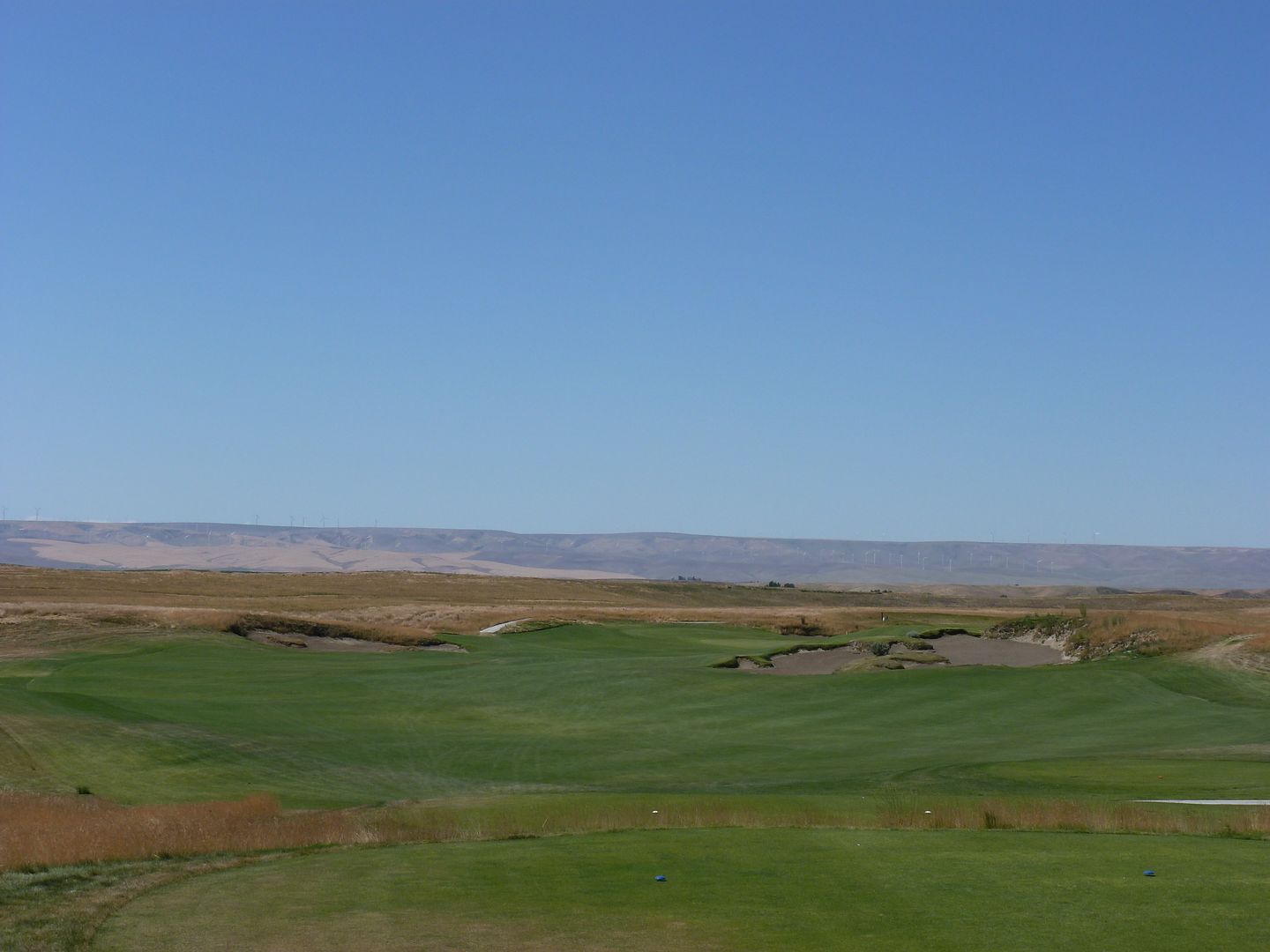
Tee shots that lay back short of the right bunker will face a 175 yard approach from a poor angle that is very awkward looking with the hill partially blocking the view of the green

Tee shots down the middle or left have a great look at the green and can take full advantage of the undulations short and left of the green that will funnel the ball down into the centre of the green.

Meanwhile, those that are able to carry the bunker on the right (about 260 yards) are rewarded with a very significant downslope that should bring the ball some 50-100 yards short of the green.

A look at the undulations short of the green (notice one cannot even see the bunker short of the green from the left):

From short and right

Even with the camera flattening the undulations, it is clear that the green has some pretty decent movement.


Hole 2: Par 4, 360 Yards
A tee shot anywhere up the middle will serve just fine, but ideally one will make a choice off the tee based on the pin location (which is in full view). Left pins should challenge the right bunkers and right pins should challenge the left tall grass. The one really big no-no is a tee shot on the right side of the fairway to a right pin.

The approach from the right to a right pin is nasty. The bunker blocks the full view of the green and the pin looks like it is floating on a tiny sliver of green. And that's not the most difficult part.

The view from the left to a right pin is more manageable.

The worst part is the mounding short of the green. Playing uphill, downwind and firm, one really want to land the ball short of the green, but two large undulations make that impossible. Anything landing short will kick well right into a deep collection area. Shots from the collection area are very difficult to get close, especially if you are playing diagonally back over the mounding.


From left of green

From behind

Hole 3: Par 5, 535 Yards
The aforementioned split-fairway par 5. From the tee it is not clear that there is a split fairway as the top portion is the only side really in view.

From the start of the fairway the split-fairway is more apparent.

The right (upper) side of the split provides a large downslope that will allow some players to have a crack at the green in two. But, the line to the green is cleverly guarded by two fairway bunkers. There is a simple lay-up available with plenty of width to the right.

The left (lower) side of the split gives a shorter(?) line into the green but requires a second shot that MUST carry the water and deal with the aforementioned fairway bunkers. I suppose if you really want to go for the green in two there is a clearer line from the left, but the layup is much more difficult, playing diagonally along the hazards. I don't think too many players will use this side of the split on purpose.

The farther right the lay-up the more difficult the approach over a green that is slightly diagonal to the fairway. More right means greater chance of finding the massive run-off right of the green.

A layup farther left leaves an easier approach, looking down the throat of the green, but the lay-up would have to contend with the bunkers/water to get to this position.


A look from down in the run-off - not a good spot to be. Also notice the undulations in the slopes running up to the green. These really make this shot tricky. Often the smartest play is to play away from them and take your medicine as they have a knack for slowing down your ball and throwing it off-line such that the ball will return to the depths of the run-off.

Hole 4: Par 4, 350 Yards
You really want to be right of the centerline bunker off the tee. At WV, the ability to land the ball short is important given the firm conditions and being forced to carry the bunker from the left is bad news.
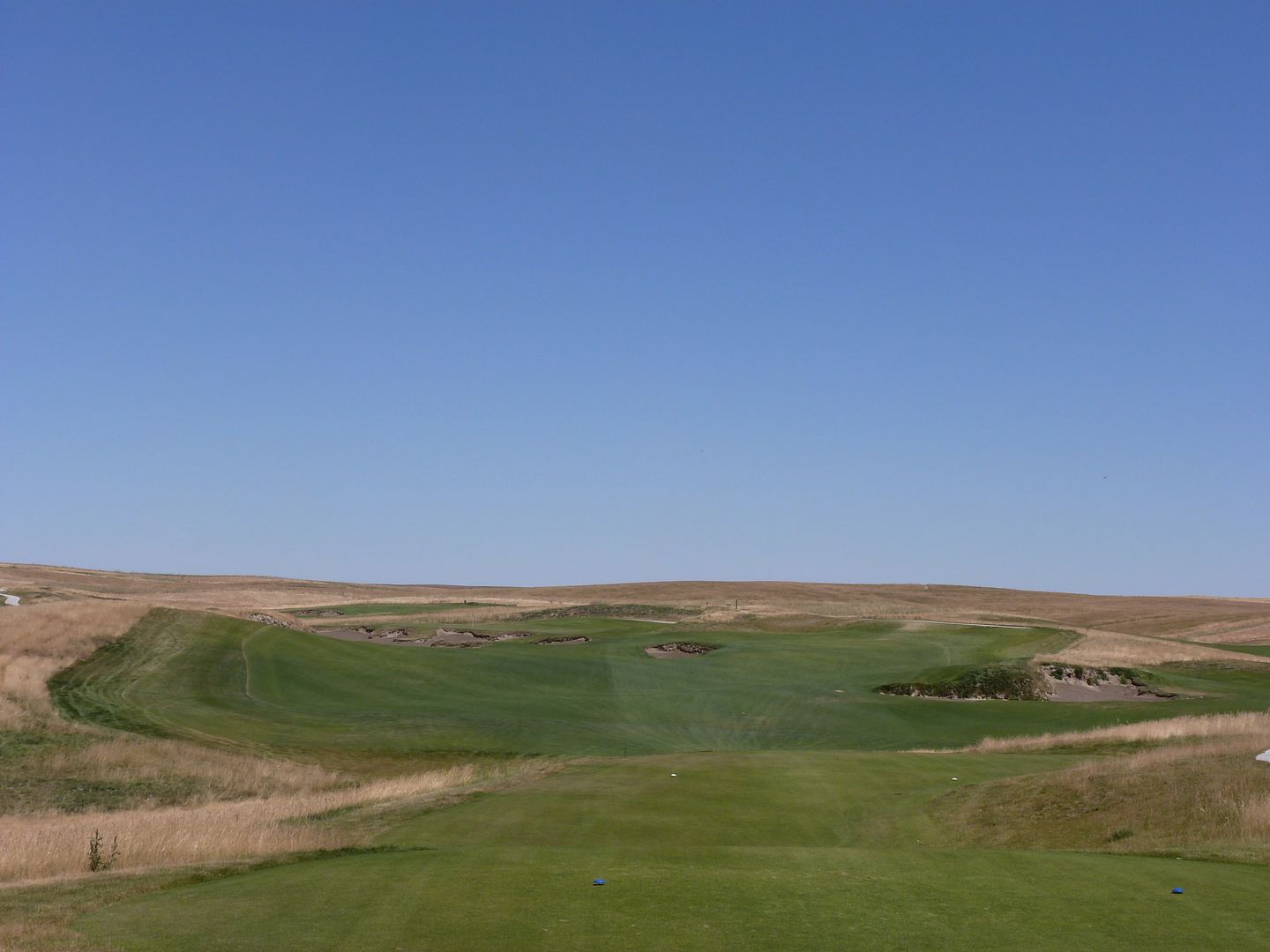

Interestingly, there is a not so insignificant downslope on the left side of the fairway into the fairway bunkers. Shots that are intended to be played short of this bunker but are pulled (and hit just a bit longer) will certainly be penalized.

One of the most undulating greens on the course with large slopes/kickers to the right of the green.

BUT, anyone getting just a bit too aggressive and going long is pretty much dead...

Hole 5: Par 4, 460 Yards
A long par 4 that plays nowhere near its yardage. Downhill and downwind, this is really no more than driver and a mid or short iron. The ideal angle is from the left, which requires the player to challenge the 'sand river.' This was one of my favorite holes at WV.

But, the fairway has a very significant slope from right to left. A player able to sling a draw off the slope can watch his ball roll forever, while a player bailing out right can watch his cut kick back toward the centre. The slope is not severe enough, however, to get the ball all the way to the left side of the fairway for the best angle into the green.

A really, really good approach. Any shot hit at the right 5 feet of the green will kick into the sand river...

There is a massive kicker short/left of the green that will feed the ball all the way to the centre of the green...
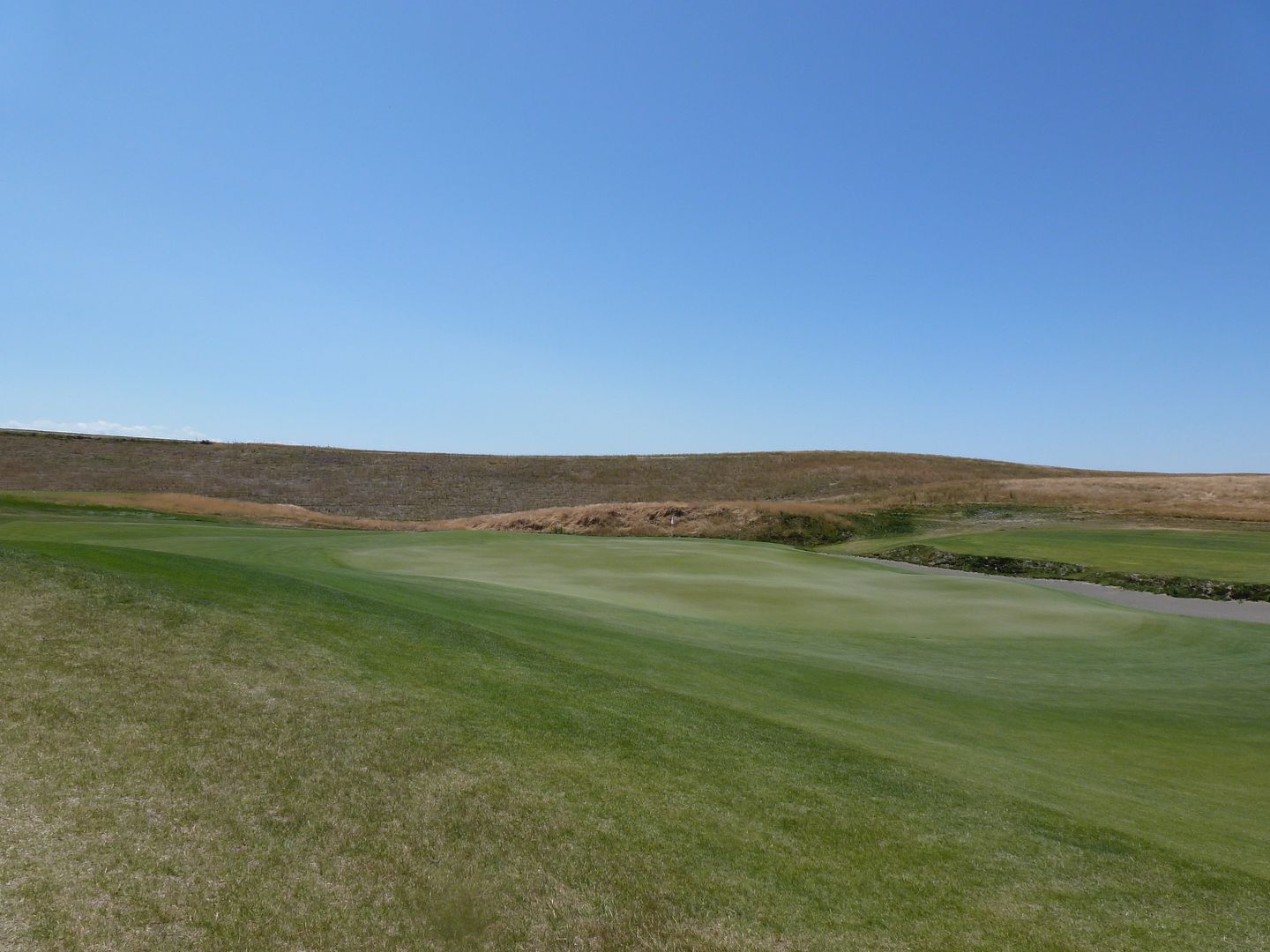
But, the kicker ends and gives way to another deep run-off. I loved this feature. Shots played at the green but pulled will carry the kicker and find the collection area. Only shots that intentionally use the slope will get its benefit.

A look from behind shows a few significant humps in the green. Lots of movement for a long par 4. If this hole played into the wind it could be a beast.

Hole 6: Par 3, 180 Yards
A solid, straightforward nader-ish par 3 with a kicker short-left and bunkers short-right and long.
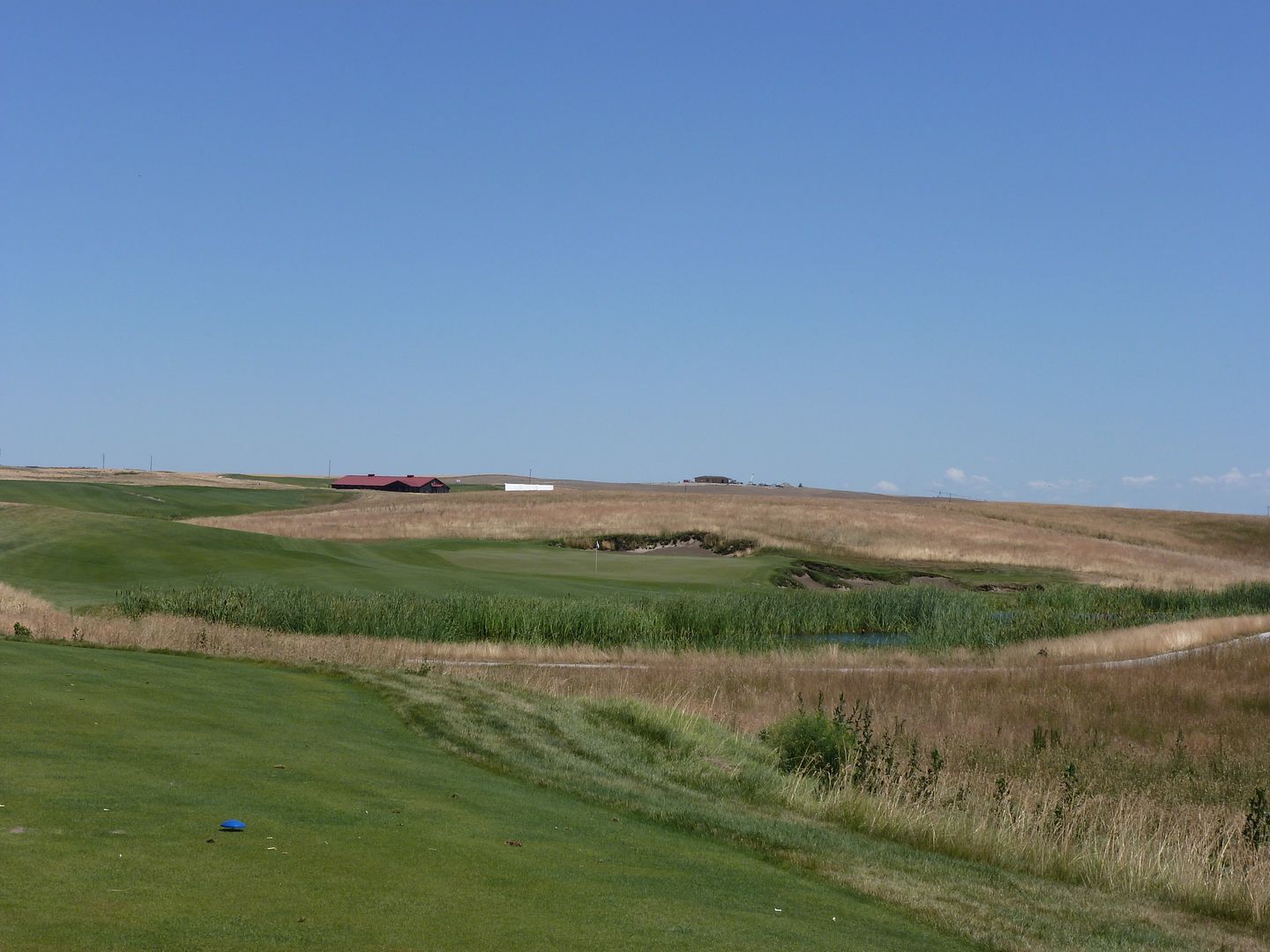


Once again, the kicker is not quite as simple as it looks. I aimed two balls at the left fringe figuring a shot that was pulled or pushed a bit would work just fine. Wrong! The kicker is very severe well left of the green and becomes less severe the closer to the green you get and becomes completely flat a couple of yards off the green. To take advantage of the kicker you have to aim for it (or miss your shot WAY left). The kicker is so severe that if you are brave enough to get your ball to land just inside the left tall grass, the ball will funnel all the way to the back-right portion of the green.

In fact, using the kicker may be the best way to get to the right portion of the green because a shot that misses right leaves a tough recovery.

Hole 7: Par 5, 535 Yards
A good hole with a great green. There is a tee somewhere in another country at 600+ and I'm sure the hole plays really different from there.
Though it is not clear from the picture, there is a bunker on the right side of the fairway about 235 yards from the tee and 250 yards to carry. The bunker on the left is about 285 yards out so most players can bail out by aiming left.

The course did a phenomenal job of rewarding risks. The fairway gets very wide over the right bunker and if you can carry it you are rewarded with a significant slope. Shots carrying the bunker should get at least an extra fifty yards of roll.

The right side of the fairway is where you really want to be off the tee. Most players can't get home in two, but you really want to lay-up short and left of the green. From there you get to look straight up the throat of the undulating 7th green.

The view from the left is blind and requires the player to carefully pick his line for his second shot.

Layups short and right of the green leave a blind approach to the green. Anyone that has played WV knows you want to be able to see this green for your third.

From short and left the punchbowl green is in full view.

Having played several Engh designs, I am still comfortable saying this is the most severe punchbowl I have ever seen. It would take a lot of time around this green to learn the right place to land the ball if you want to use the slopes. For example, I landed a ball well into the slope back right and had it roll of the front-left part of the green.
I chipped three balls from where this next picture was taken and tried to use the slope just past the pin... all three rolled back well past the pin (you can see them if you look closely).
Perhaps the slopes are too severe. I would need to see the course more times to really say either way.


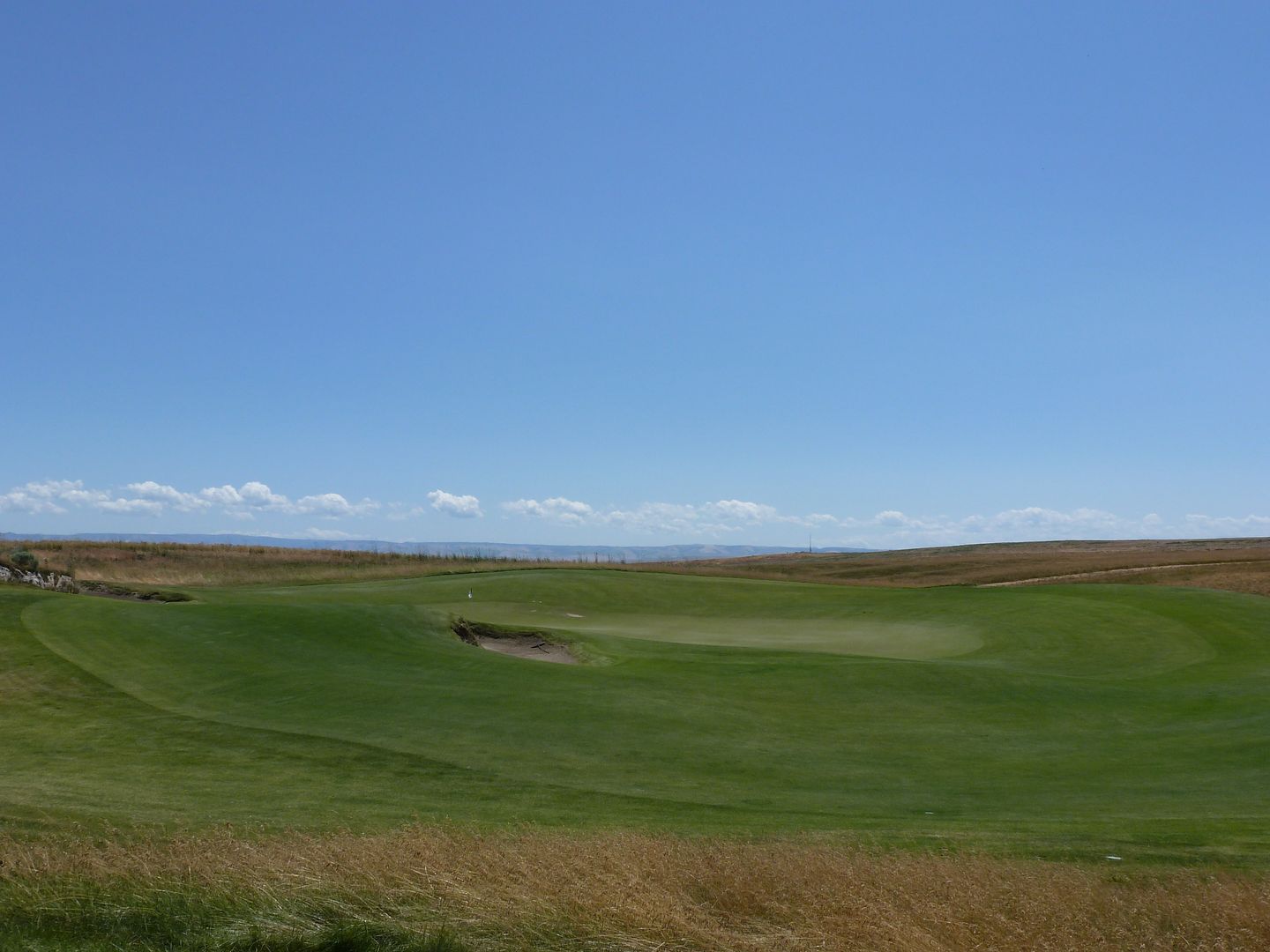
Hole 8: Par 3, 200 Yards
Having just finished with 7 green, I think I was slope-crazy. When I first looked at 8, I thought that I should try to play a draw and land the ball right of the right bunker and use the slope there to bring the ball onto the green.


I'm not sure how I missed it, but I didn't notice this massive slope short-left of the green that one can use to funnel the ball onto the green.
For those that have played WV, is the slope obvious from the tee? Looking at it now I have no idea how I didn't see it.

The yardage guide says this is the most difficult green on the course. Again, I disagree (see post on hole 7), but there is a significant ridge running through the center of the green. This slope makes shots from the bunker to a back pin extremely difficult as you have to carry the ball a long way to get over the slope and stop it quickly. I found out that shots landing into the slope will run all the way down to the front edge of the green leaving a very difficult two-putt.


Hole 9: Par 4, 430 Yards
A hole I didn't overly care for - just a way to get from 8 back to the clubhouse. Not a ton to add to the pictures here. Shots that challenge the left bunker are left with an approach that does not need to carry the water on the 2nd shot and provide easier access to a back-right pin.

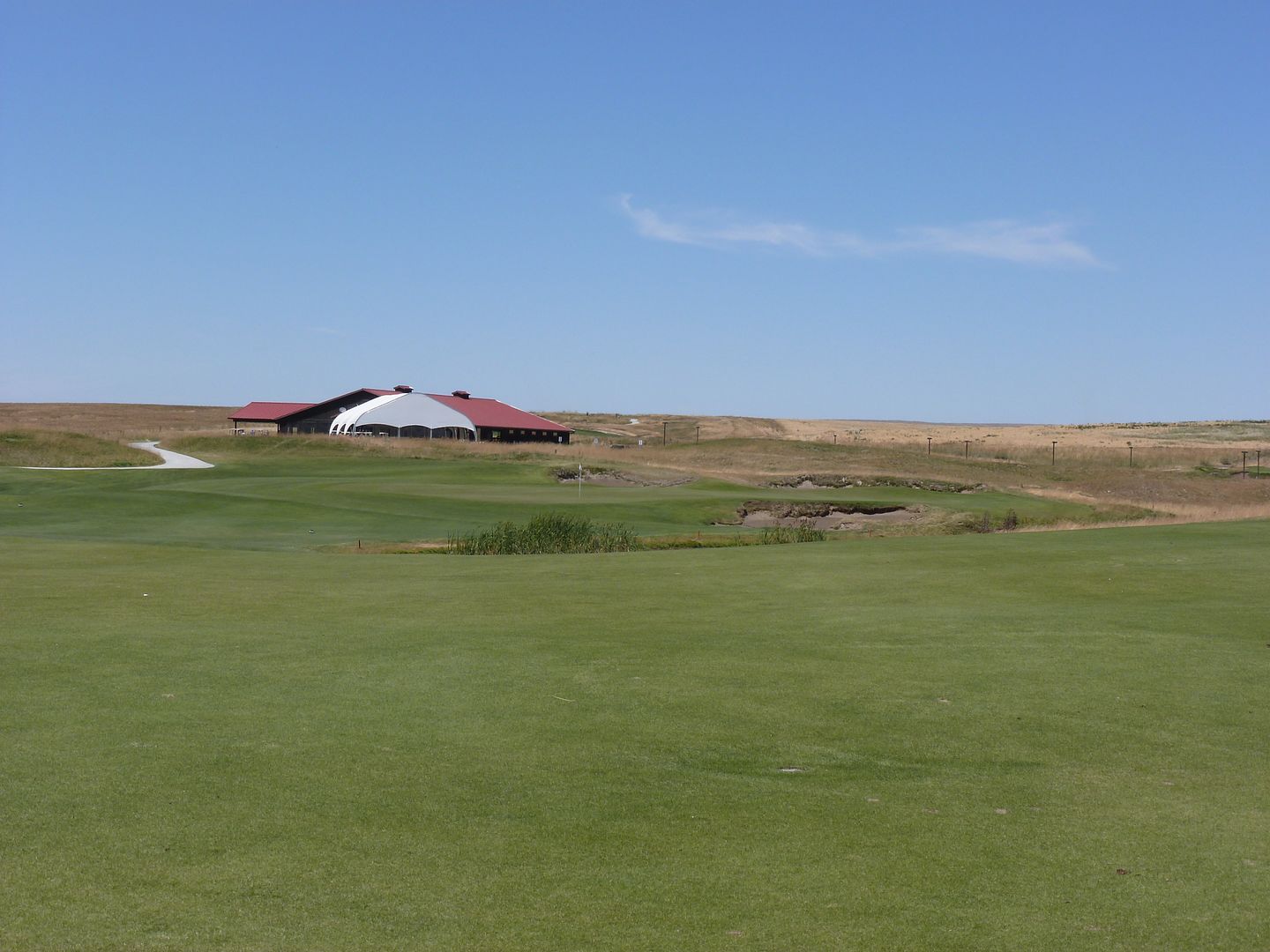

Another difficult green at WV with significant contouring, especially around the easier (front) pin positions. The back portion of the green is fairly flat, rewarding a player that gets his shot near the most difficult pin on the green.

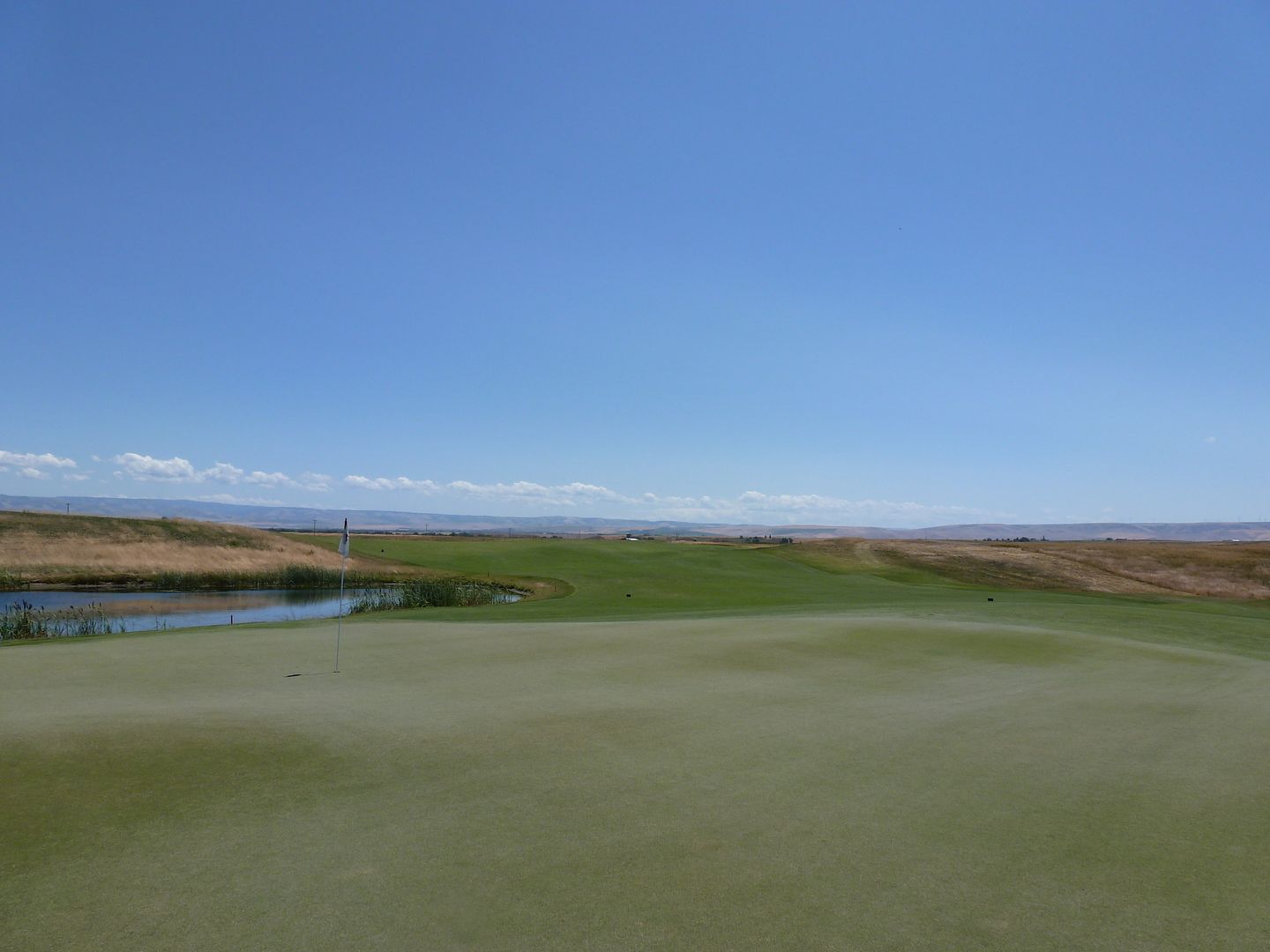
Hole 10: Par 5, 580 Yards
A very straightforward par 5, bunkerless except for a single bunker in front of the green that defines the hole.
The tee shot has a ton of width. Anything between tall grass left and right works just fine.

Strategy on the second shot is simple too. Get the ball in the right side of the fairway to give a clear look at the green.

This is one of the most difficult greens at WV. Approaching from the left means you can't see the putting surface, but...

The further right your lay-up...

The clearer the view of the green.

Missing this green means big trouble. The hole is simple and you are supposed to hit this green in regulation. If you don't you are unlikely to walk away with par.
There are large run-offs from all directions of the green. If you miss your target by just a few yards, you will roll at least 10-15 yards from the surface. Also notice the green is at a diagonal to an approach from the right, making a shot from there significantly more difficult.

To make matters worse, the run-offs are significantly contoured with several 'humps'. Much like undulations on a green, these humps make it very difficult to get the ball close to the hole. If humps of this size were placed on the green, the word unfair would certainly be used by some, but by placing them in the run-offs, it's all good...

As previously mentioned, one the most significantly contoured greens at WV. The simplicity of the hole means you are supposed to hit this green in regulation, and probably reasonably close to the hole. If you don't, 5 is a tough score to make.

Hole 11: Par 3, 155 Yards
A little more deception with the slopes at WV. One (or at least I) expected that shots landing over the bunker front-right would kick towards the back-left. Wrong again. Only shots well right of the green can use the kicker.


Overall, a straightforward short par 3, but this one large hump left of the green made shots that miss left very difficult. It's amazing how one bump can change the nature of a hole.

Hole 12: Par 4, 405 Yards
A very solid par 4. The farther left the tee shot, the easier approach, but the sand river is back in play guarding the left side of the fairway. Fortunately, the fairway slopes severely right to left, allowing the player to aim down the right side of the fairway and still be left with an approach from the left.

The view from where the majority of tee shots will end up.

As will be seen, you really don't want to miss the approach left. Again, the clever player can play away from the danger using this massive slope short-right of the green to funnel the ball down to the hole (though it is not apparent from the fairway that this slope is here to be used).

A look at the trouble left shows that a miss left is lucky if it finds the bunker. The more natural stuff is just bad news.

A look at the green shows a green with less internal contouring than many at WV, but some rather severe undulations at the back-right and back-left portions of the green.
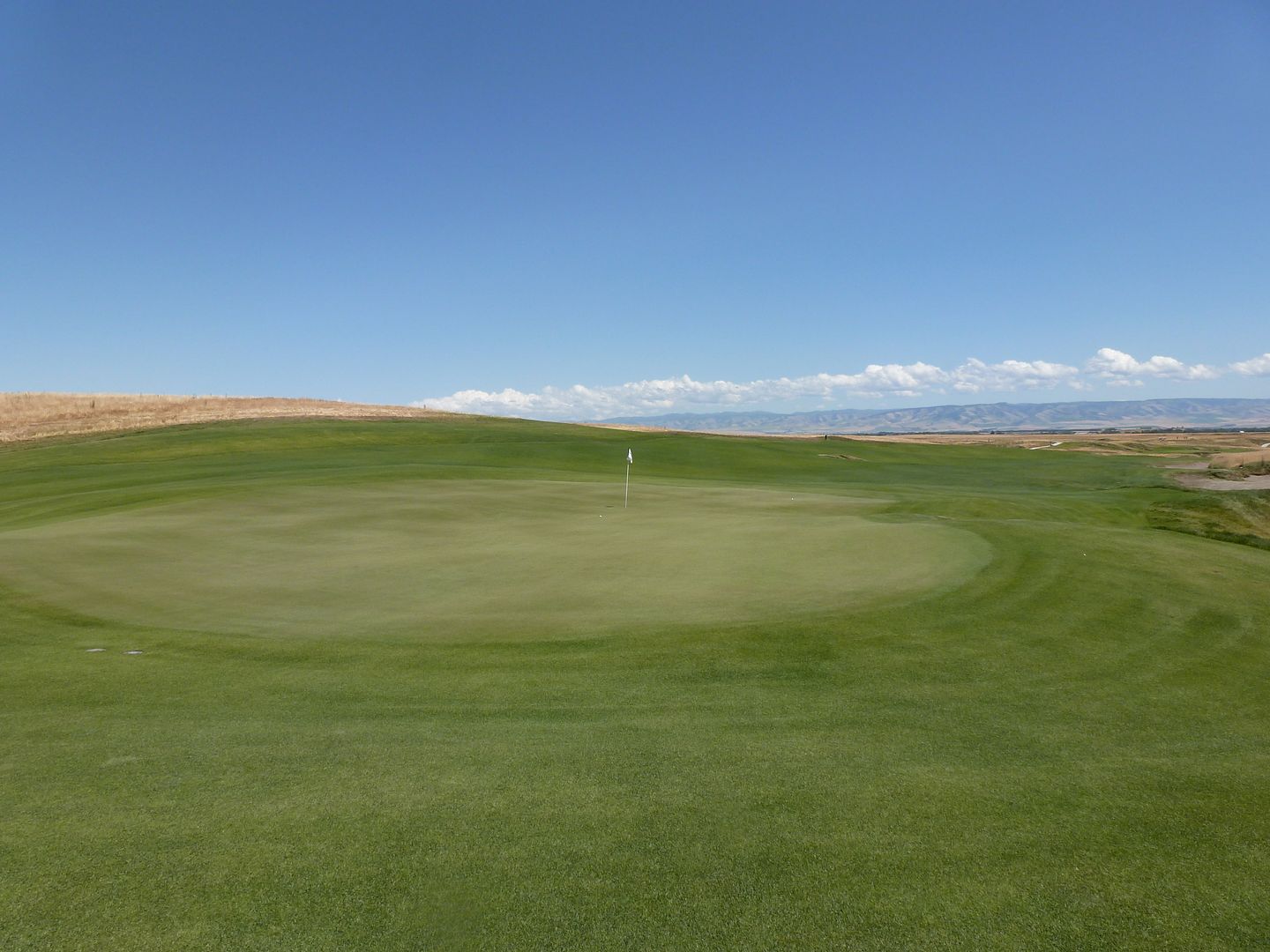
A look from behind at the kicker short-right of the green.

A look at the green (and a better look at the trouble left of the green) from the next tee:

Hole 13: Par 4, 435 Yards
In my opinion, one of the weakest holes on the course. When I was in the fairway, I was thinking that this is the type of hole that one tries to find interesting when playing a very good golf course. Sure there are a couple of interesting slopes and run-offs, but really it is a mediocre hole. If it was at a poorer course, it would just get passed-off as one OK hole among many. So here it is...
There are bunkers right and left off the tee. Both are reachable with the ones on the right being carry-able by the longer hitters.

There is a large downslope over the right bunkers and it seems they are widening the fairway to reward players who carry the bunkers. Still, the angle from the right is miserable.

The preferred angle is from the left and allows the player to use the kicker short-right of the green.

Said kicker.

Once again, the kicker cannot be used by accident. Shots hit long enough to fly onto the green, but hit at the kicker, will fly the kicker and find this very difficult runoff.

Hole 14: Par 3, 135 Yards
A simple but fun short par 3. There is a little sideboard to the right. There is also one long that is likely more to protect good shots from running into the back bunkers than to actually be used on purpose (of course this backboard means shots that do find the back bunkers are dead). There is also a bit of a false front at the front-right portion of the green and a very large false front in the middle of the green (just left of the pin in the picture) that will have pretty good shots rolling all the way back into the front bunkers.


Again tons of undulation on the green. Another one of those holes where you are supposed to get the ball close to the hole off the tee. If you don't three-putts are very likely.

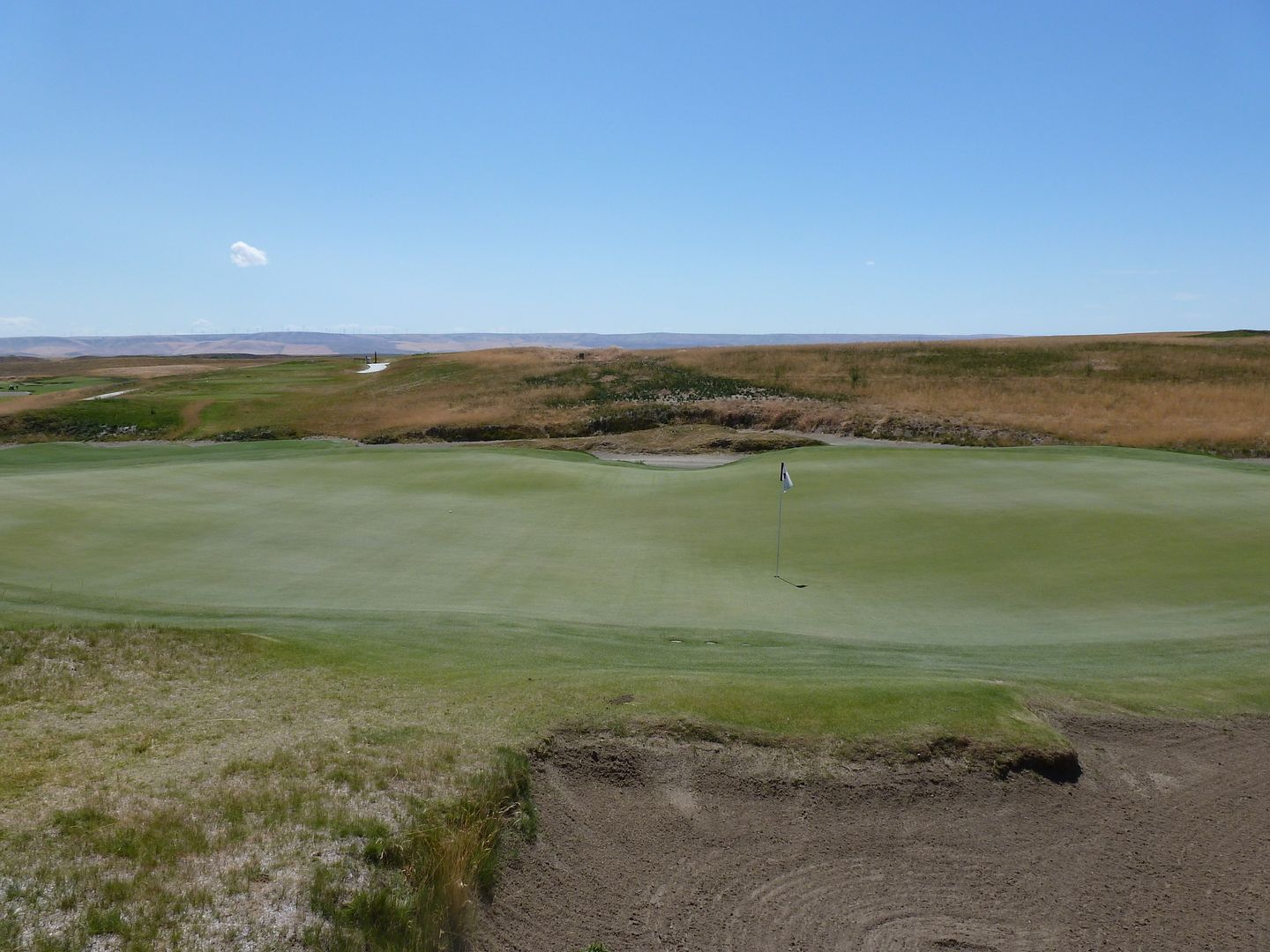
Hole 15: Par 5, 470 Yards
Easily my favorite hole at WV. It's not the kind of short par 5 that will yield the 3-7 score range, more likely the 3-5 range. It's a hole that requires really well thought-out and executed shots to make better than par, but making par should not be a problem.
Off the tee, the shortest line to the green is to take the drive up the left. The best line to the pin is from the right and to get to that angle you have to challenge the bunker on the right. No matter what route you take off the tee, you have to be precise.

A look from the right shows a very cleverly placed bunker 40 yards short of the green (I really, really liked the placement of the bunker). From the right you don't need to carry the greenside bunkers to find the green, but you do need to carry the fairway bunker. The player has a very real choice to make whether or not to try to carry the bunker.

Not challenging the fairway bunker short of the green leaves a very difficult third to a very shallow green.

Tee shots that carry the bunker should kick forward and left toward the green leaving a straightforward approach up the throat of the green.

A look from behind shows (1) just how shallow the green is, and (2) how diagonal the green lies to the line of play. One really wants to get the ball short-right of the green to leave a simple third.
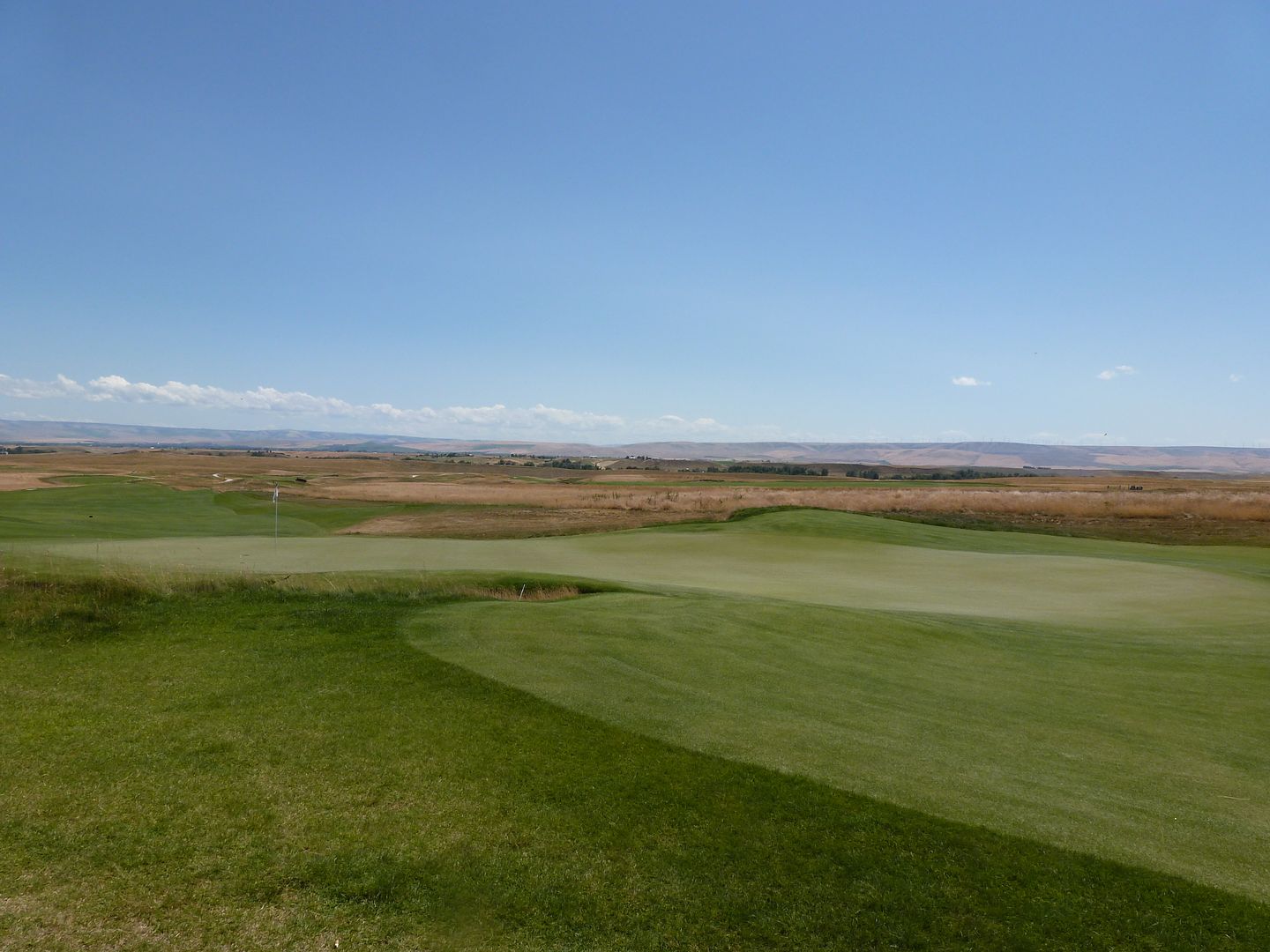

Hole 16: Par 3, 175 Yards
A hole that would likely be better without the front-right bunker
 .
.It is amazing how two little bumps just short of the green can turn a simple, benign par-3 into one of significant interest. The general slope of the land short of the green should kick balls right on to the green, but the two bumps pictured mean that players attempting to use this slope will subject themselves to a 'luck-of-the-draw' bounce.



Having played this hole only to a right pin it was difficult to picture how the hole would play to a back-right pin. As the pictures show, there is significant internal contouring on this green and I suspect there is a way to get the ball back-right without messing with that bunker.
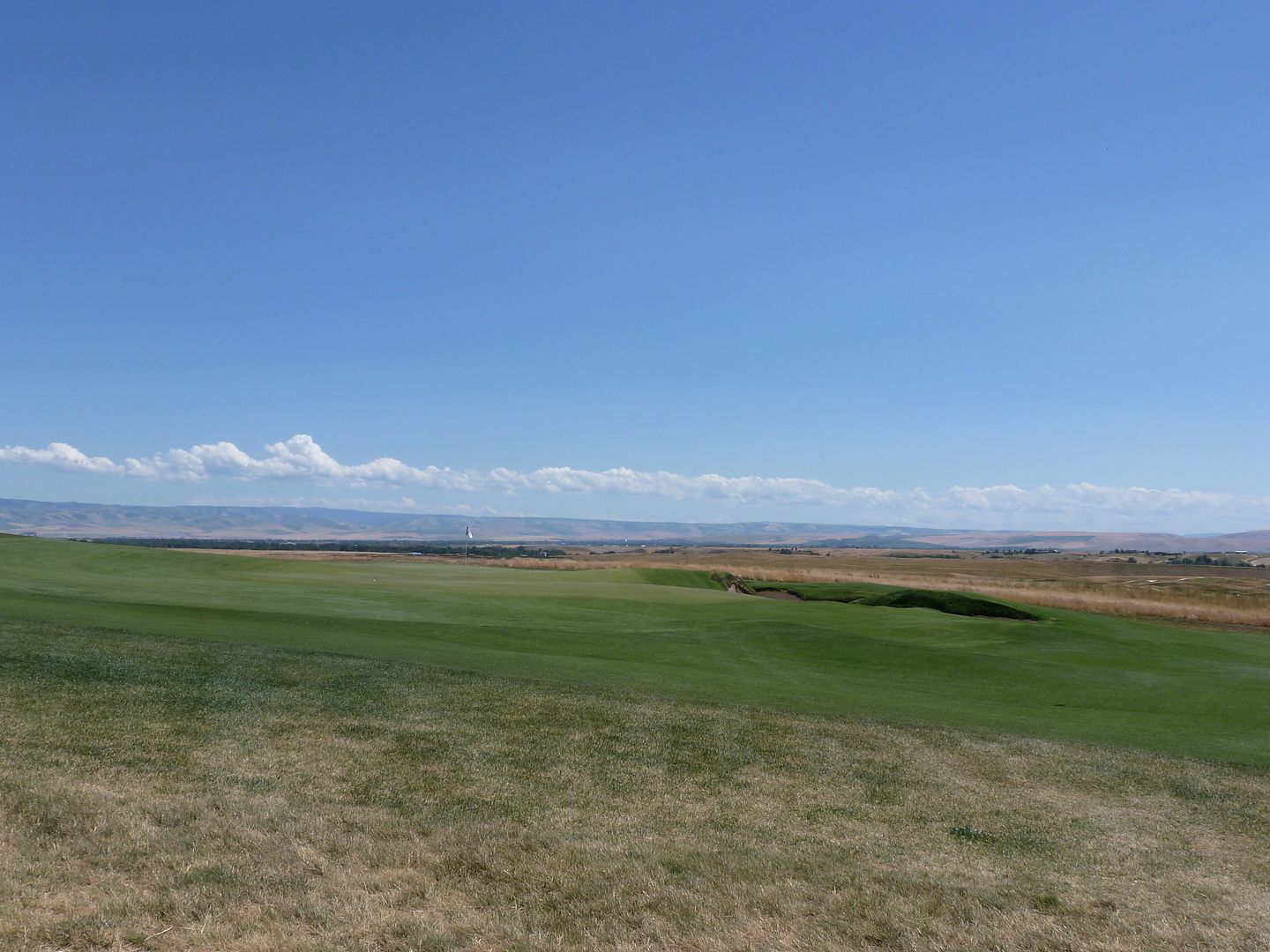
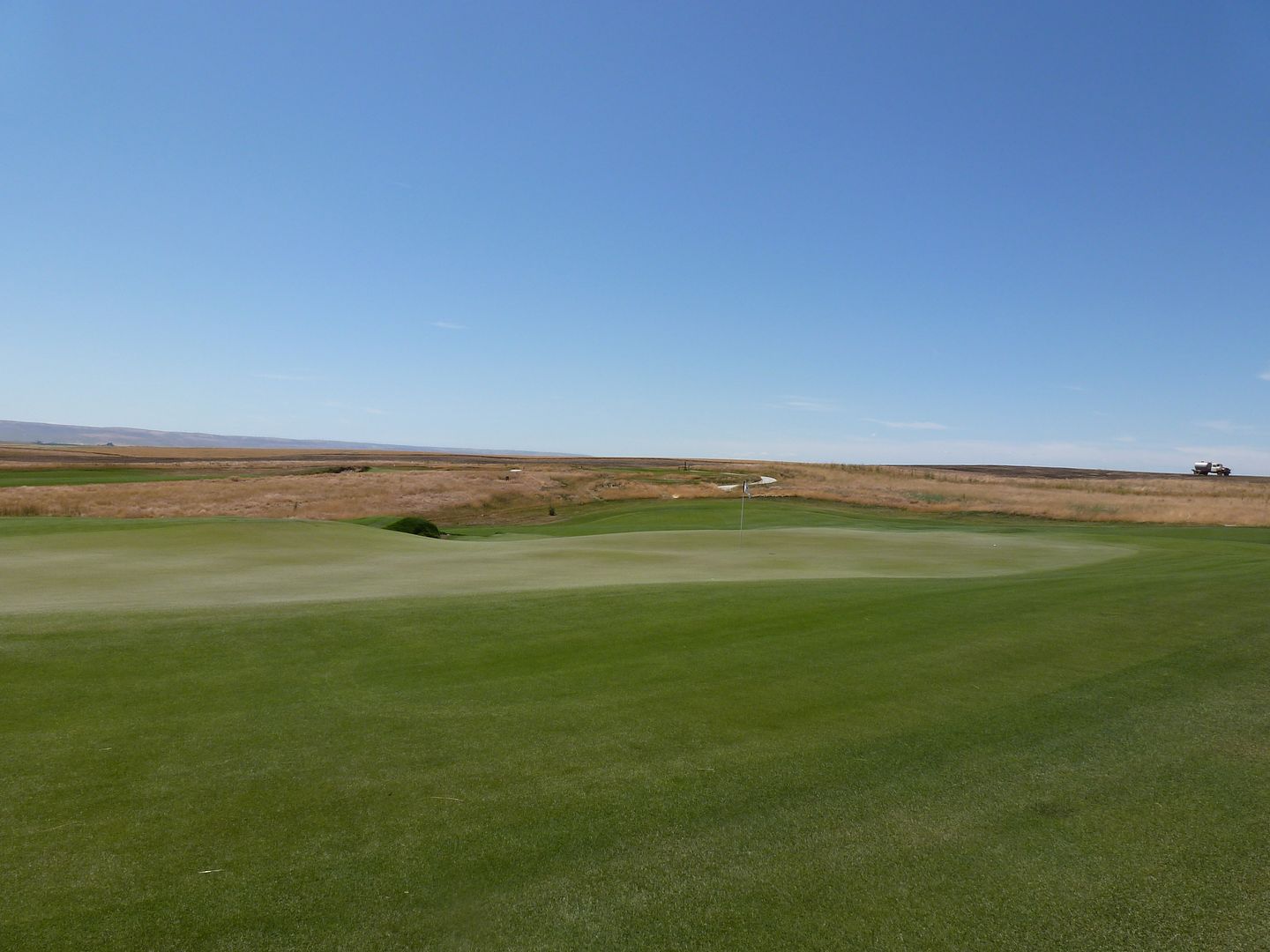
Hole 17: Par 4, 400 Yards
Some staggered bunkering off the tee provides the need to make a decision off the tee. You can hit plenty of club at keep it short of either the right or left bunkers (about 240 yards), but into this green, you may want as short an iron as possible. Approach from the left is ideal.

The approach from about 150 from the centre of the fairway.

Did you think that bunker on the left off the tee was a bunker? So did I. I actually don't know what to call it. Maybe a sod-wall? Whatever it is, it is very cool. The big risk here is having the ball stop very close to the wall leaving an impossible stance. I spent a bunch of minutes hitting and throwing balls at the wall (probably 20 balls). I only had one stay in a spot where a righty would have no chance and that ball was moving very, very slowly when it hit the wall. Most would simply hit it and bounce a few feet off leaving a fairly simple shot (like the balls in the photo). Still, the possibility of having the ball stop next to the wall is reason enough for a righty to play away from it.

A very rumpled approach and a significant false front. Despite the availability of an open green front, you really want to fly the ball at least to the front-edge, otherwise you will be dealing with a lot of chance.

Another green with very significant internal contouring but less severe run-offs than are typical at WV.


Hole 18: Par 5, 550 Yards
Staggered bunkering once again, but playing downhill and downwind one simply will do their best to avoid the hazards.


For the second shot, one has several options:
(1) go for the green in two: probably easiest from the left as there is no forced carry over bunkers short of the green
(2) lay-up, but challenge fairway bunkers short of green
(3) lay-up short of bunkers


From 125 yards out, short of all fairway bunkers

From 50 yards out, past all fairway bunkers. Note significant false front.

Long/Right is not the place to miss the final green at WV



No comments:
Post a Comment